
Off-road travel represents a unique intersection between adventure and natural discovery, offering unprecedented access to some of the world's most pristine wilderness areas. This specialized form of outdoor exploration allows travelers to venture beyond traditional boundaries, accessing remote locations that would otherwise remain hidden from view. The combination of mechanical capability and natural immersion creates an experience that bridges the gap between modern convenience and raw wilderness engagement.
Essential off-road vehicle equipment for wilderness navigation
Successful wilderness navigation requires a carefully curated selection of specialized equipment designed to handle the unique challenges of off-road travel. The foundation of any off-road capable vehicle begins with proper mechanical preparation, focusing on essential systems that enable safe passage through challenging terrain while minimizing environmental impact.
All-terrain tires and advanced suspension systems for rocky trails
All-terrain tires serve as the critical interface between vehicle and terrain, requiring specific characteristics to maintain traction across varied surfaces. Modern all-terrain tires incorporate advanced compounds and tread patterns that provide optimal grip while resisting damage from sharp rocks and other obstacles. The most effective designs feature reinforced sidewalls and aggressive shoulder blocks for enhanced protection and climbing ability.
GPS navigation tools and satellite communication devices
Navigation in remote areas demands redundant systems that function independently of cellular networks. Professional-grade GPS units with topographic mapping capabilities provide essential location awareness, while satellite communication devices ensure emergency contact capability in areas beyond traditional coverage. These tools should be backed up with traditional map and compass skills for complete navigational security.
Recovery gear and emergency equipment for remote areas
A comprehensive recovery kit represents an essential safety net for wilderness travel. Standard equipment includes hi-lift jacks, recovery straps, and ground anchors. Emergency supplies should encompass medical kits, water purification systems, and sufficient food reserves for extended delays. The strategic placement of this equipment within the vehicle ensures quick access during critical situations.
Remote camping locations accessible only by 4x4 vehicles
The true value of off-road capability emerges in accessing remote camping locations that offer unparalleled solitude and natural immersion. These destinations provide opportunities for deep wilderness experiences while requiring careful planning and responsible travel practices.
Moab's hidden backcountry campsites in Utah
The red rock landscape surrounding Moab contains numerous secluded camping areas that showcase the raw beauty of the Colorado Plateau. These sites require technical driving skills to access, but reward visitors with pristine desert environments and spectacular stargazing opportunities. Careful site selection focuses on previously established locations to minimize environmental impact.
Death Valley's remote desert camping areas
Death Valley's vast expanse includes numerous backcountry camping opportunities that demonstrate the stark beauty of desert ecosystems. Access often requires navigating challenging washboard roads and sandy washes, making proper vehicle preparation essential. These remote sites offer unparalleled solitude and opportunities for wildlife observation.
The most profound wilderness experiences often require venturing beyond established pathways, accessing locations where natural processes remain largely undisturbed by human presence.
Environmental impact and responsible Off-Road practices
Responsible off-road travel requires a deep understanding of environmental stewardship principles and their practical application. Success in minimizing impact depends on both technical skill and ethical decision-making throughout each journey.
Tread lightly principles for trail conservation
The Tread Lightly framework provides essential guidelines for responsible off-road travel. Key principles include:
- Travel only on designated routes and established trails
- Respect closure signs and seasonal restrictions
- Avoid operation during wet conditions when trails are most vulnerable
- Cross streams only at designated fording points
Wildlife observation guidelines during off-road expeditions
Successful wildlife observation requires maintaining appropriate distances and minimizing disturbance to natural behaviors. Vehicle positioning should consider wind direction and natural barriers, while engine noise reduction helps preserve the natural soundscape. The use of spotting scopes and binoculars enables detailed observation without close approach.
Planning multi-day off-road nature expeditions
Extended wilderness expeditions demand comprehensive planning that accounts for variable conditions and potential challenges. Success depends on thorough preparation across multiple domains, from technical vehicle readiness to detailed route analysis.
Weather pattern analysis for safe trail navigation
Weather conditions significantly impact both trail conditions and travel safety. Professional expedition planning incorporates detailed weather forecasting and historical pattern analysis to identify optimal travel windows. Special attention focuses on:
- Seasonal precipitation patterns affecting trail conditions
- Temperature extremes impacting vehicle performance
- Wind patterns influencing camping site selection
- Storm system tracking for safety management
Supply chain management for extended wilderness stays
Extended wilderness travel requires careful management of consumable resources, including fuel, water, and food supplies. Professional-grade storage systems protect supplies from extreme conditions while maintaining accessibility. The use of GPS waypoints helps mark cache locations and potential resupply points along extended routes.
Successful wilderness navigation combines technical expertise with careful observation of natural indicators, creating a comprehensive awareness of position and environmental conditions.
Photography and nature documentation techniques
Documenting wilderness experiences requires specialized equipment protection and techniques adapted to mobile conditions. Professional-grade camera systems must withstand vibration and environmental exposure while remaining readily accessible for spontaneous opportunities.
Camera equipment protection for rough terrain
Protecting sensitive photography equipment during off-road travel requires specialized storage solutions and mounting systems. Professional-grade cases provide impact protection while maintaining quick access capabilities. Vibration isolation mounts protect equipment during transit while enabling rapid deployment for wildlife photography.
Wildlife photography from off-road vehicles
Vehicle-based wildlife photography presents unique opportunities and challenges. Successful techniques include the use of specialized window mounts and stabilization systems. The vehicle itself serves as a mobile blind, enabling close observation while minimizing wildlife disturbance when properly positioned.
Remote-controlled camera systems extend photographic capabilities while maintaining safe distances from wildlife. These systems incorporate long-range triggers and weather-sealed housings for operation in challenging conditions.